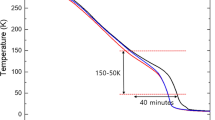Abstract
We demonstrated a novel method to measure the unloaded quality factor (Q factor) of high-Q resonant cavities. This method was used to obtain data with low errors and calculate the unloaded Q factor. This procedure was more reliable than traditional methods. The data required for the method were near the resonant frequency, not at the half-power points of the reflection coefficient curve or Smith chart. We applied the new method to measure a resonant cavity with an unloaded Q factor of ~ 100,000, obtaining good agreement between the measured and theoretical results.














Similar content being viewed by others
References
C.P. Wang, W.C. Fang, D.C. Tong et al., Design and study of a C-band pulse compressor for the SXFEL linac. Nucl. Sci. Tech. 25, 020101 (2014). https://doi.org/10.13538/j.1001-8042/nst.25.020101
M. Franzi, J.W. Wang, V. Dolgashev et al., Compact rf polarizer and its application to pulse compression systems. Phys. Rev. Accel. Beams 19, 062002 (2016). https://doi.org/10.1103/PhysRevAccelBeams.19.062002
Y. Nishimura, K. Sakaue, M. Nishiyama et al., Design of a two-cell rf-deflector cavity for ultra-short electron bunch measurement. Nucl. Instrum. Methods A 764, 291–298 (2014). https://doi.org/10.1016/j.nima.2014.07.035
X. P. Jiang, J. R. Shi, P. Wang et al., C-band deflecting cavity for bunch length measurement of 2.5 MeV electron beam, in Proceedings of 7th International Particle Accelerator Conference (IPAC), Busan, Korea, May 2016, pp. 386–388
L. Auditore, R.C. Barna, D. De Pasquale et al., Pulsed 5 MeV standing wave electron linac for radiation processing. Phys. Rev. Accel. Beams 7, 030101 (2004). https://doi.org/10.1103/PhysRevSTAB.7.030101
L. Zhang, J.R. Shi, P. Wang et al., An X-band linac with tunable beam energy, in Proceedings of 6th International Particle Accelerator Conference (IPAC), Richmond, US, May 2015, pp. 1644–1646
S. Shahid, J.A.R. Ball, C.G. Wells et al., Reflection type Q-factor measurement using standard least squares methods. IET Microw. Antennas Propag. 11, 426–432 (2011). https://doi.org/10.1049/iet-map.2010.0395
A.J. Canós, J.M. Catalá-Civera, F.L. Peñaranda-Foix et al., A novel technique for deembedding the unloaded resonance frequency from measurements of microwave cavities. IEEE Trans. Microw. Theory Tech. 54, 3407–3416 (2006). https://doi.org/10.1109/tmtt.2006.877833
P. Wang, L.H. Chua, D. Mirshekar-Syahkal, Accurate characterization of low-Q microwave resonator using critical-points method. IEEE Trans. Microw. Theory Tech. 53, 349–353 (2005). https://doi.org/10.1109/TMTT.2004.839931
J.M. Drozd, W.T. Joines, Determining Q using S parameter data. IEEE Trans. Microw. Theory Tech. 44, 2123–2127 (1996). https://doi.org/10.1109/22.543972
D. Kajfez, Linear fractional curve fitting for measurement of high Q factors. IEEE Trans. Microw. Theory Tech. 42, 1149–1153 (1994). https://doi.org/10.1109/22.299749
D. Kajfez, Q-factor measurement with a scalar network analyser. Proc. Inst. Elect. Eng. Microw. Antennas Propag. 142, 369–372 (1995). https://doi.org/10.1049/ip-map:19952142
E.-Y. Sun, S.-H. Chao, Unloaded Q measurement—the critical points method. IEEE Trans. Microw. Theory Tech. 43, 1983–1986 (1995). https://doi.org/10.1109/22.402290
Y.Z. Wang, Y. Xie, T.L. Zhang et al., Quality factor measurement for MEMS resonator using time domain amplitude decaying method. Microsyst. Technol. 21, 825–829 (2015). https://doi.org/10.1007/s00542-014-2161-4
D. Alesini, in Proceedings of the CAS–CERN Accelerator School: RF for accelerators, ed. by R. Bailey, Ebeltoft, Denmark, 8–17 June 2010, edited by, CERN-2011-007, pp. 95–116, 125–147
J.R. Bray, L. Roy, Measuring the unloaded, loaded, and external quality factors of one- and two-port resonators using scattering-parameter magnitudes at fractional power levels. Microw. Antennas Propag. IEE Proc. 151, 345–350 (2004). https://doi.org/10.1002/mop.29716
P.J. Petersan, S.M. Anlage, Measurement of resonant frequency and quality factor of microwave resonators: comparison of methods. Appl. Phys. 84, 3392–3402 (1998). https://doi.org/10.1063/1.368498
K.D. McKinstry, C.E. Patton, Methods for determination of microwave cavity quality factors from equivalent electronic circuit models. Rev. Sci. Instrum. 60, 439–443 (1989). https://doi.org/10.1063/1.1140397
D.-H. Han, Y.-S. Kim, M. Kwon, Two port cavity Q measurement using scattering parameters. Rev. Sci. Instrum. 67, 2179–2181 (1996). https://doi.org/10.1063/1.1147034
W. Xu, S. Belomestnykh, I. Ben-Zvi et al., Improvement of the Q-factor measurement in RF cavities, in Proceedings of 4th International Particle Accelerator Conference (IPAC), Shanghai, China, May 2013, pp. 2489–2491
D. Kajfez, Random and systematic uncertainties of reflection-type Q-factor measurement with network analyzer. IEEE Trans. Microw. Theory Tech. 51, 512–519 (2003). https://doi.org/10.1109/TMTT.2002.807831
Author information
Authors and Affiliations
Corresponding author
Additional information
This work was supported by the National Key Research and Development Program of China (No. 2016YFA0401902).
Rights and permissions
About this article
Cite this article
Wang, P., Shi, JR., Xiong, ZF. et al. Novel method to measure unloaded quality factor of resonant cavities at room temperature. NUCL SCI TECH 29, 50 (2018). https://doi.org/10.1007/s41365-018-0383-3
Received:
Revised:
Accepted:
Published:
DOI: https://doi.org/10.1007/s41365-018-0383-3




